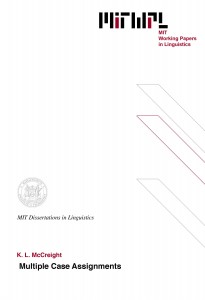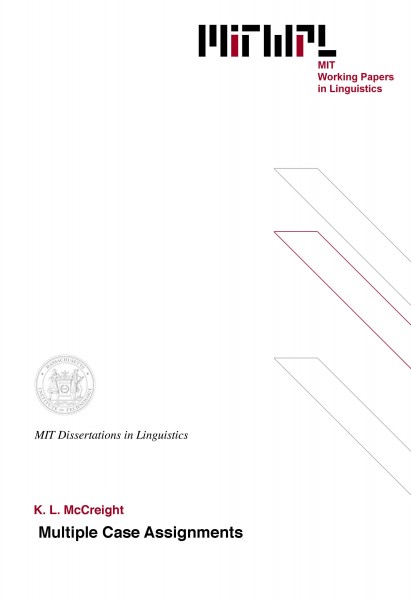Multiple Case Assignments
K. L. McCreight, 1988
We examine the data of multiple case assignments in an attempt to determine the nature of the mapping between abstract case and morphological case. We consider three potential sources of multiple case percolation, agreement, and assignment. We argue that a potential multiple case assignment may be resolved by prevention of a structural case assignment; by prevention of case agreement; by reduction of assigned case features; or by morphological accommodation of the multiple cases.
We claim that accommodation of a multiple case by morphologically neutral forms reflects a general morphological process. We suggest that case assignment be represented as assignment of a positive case feature value, with morphologically neutral forms represented in the lexicon with underspecified case feature values.
We claim that case agreement between a trace and an antecedent in a non-argument position is forced by cyclic application of the Case Filter. This case transmission requirement, together with an agreement requirement between a relative pronoun and an empty pronominal head, creates case matching effects in free relatives. Reduction of such multiple case assignment is subject to a semantic constraint of recoverability, and creates resolution hierarchies of the general form, less informative cases < more informative cases.
Thesis Supervisor: Kenneth Hale
Title: Professor of Linguistics
Table of Contents
Chapter One The mapping from abstract case to morphological case 1
1.0 Introduction 1
1.1 Evidence from single case assignment 4
1.1.1 First model of case mapping 11
1.1.1.1 Assignment 13
1.1.1.2 Adjustment 14
1.1.1.3 Realization 15
1.2 Evidence from multiple case assignment 15
1.2.1 Sources of multiple case 17
1.2.2 Resolution of multiple case 18
1.2.2.1 Prevention 18
1.2.2.2 Reduction 19
1.2.2.3 Accomodation 19
1.2.3 Revised model of case mapping 20
1.3 Outline of thesis according to case mapping model 21
1.3.1 Chapter Two: accomodation 22
1.3.2 Chapter Three: percolation-induced multiple case 22
1.3.3 Chapter Four: agreement-induced multiple case 22
1.3.4 Chapter Five: assignment-induced multiple case 23
1.3.5 Appendix A: case-agglutinating languages 23
Chapter Two Accomodation 24
2.1 Introduction 24
2.2 Data 25
2.2.1 Syncretic resolution of movement-derived multiple case 25
2.2.2 Syncretic resolution of coordination-derived multiple case 31
2.2.3 Interaction between case and other grammatical properties 33
2.2.4 Limitations on syncretic resolution 34
2.3 Representations 42
2.3.1 Case feature analysis 42
2.3.2 Paradigmatic analysis 44
Chapter Three Percolation-induced multiple case 56
3.1 Percolation as a source of multiple case in Russian numeral
phrases 57
3.2 Resolution of percolation-induced multiple case: case hierarchy 60
3.2.1 Case hierarchy is not accomodation 60
3.2.2 Case hierarchy as reduction 63
3.2.2.1 Analysis 63
3.2.2.2 Problems 64
3.2.2.2.1 Russian relative clauses 65
3.2.2.2.2 Comparison with Polish 65
3.2.2.2.2.1 Polish numeral phrases 65
3.2.2.2.2.2 Polish relative clauses 66
3.2.3 Case hierarchy as prevention of percolation 67
3.2.4 Case hierarchy as a combination of prevention and
reduction 68
3.3 Alternative: Q head and no percolation 70
3.4 Conclusion 72
Chapter Four Agreement-induced multiple case 74
4.1 Introduction 74
4.2 Agreement as a source of multiple case assignment 74
4.3 Resolution of agreement-induced multiple case 75
4.3.1 Accomodation 75
4.3.2 Prevention 76
4.3.3 Reduction 76
4.4 Agreement-induced multiple case in relative clauses 76
4.4.1 Structure of headed relatives 78
4.4.1.1 External head relatives 78
4.4.1.1.1 Scope of the determiner 79
4.4.1.1.2 Conjoined heads 80
4.4.1.1.3 Stacking 82
4.4.1.2 Internal head relatives 83
4.4.2 Free relatives 85
4.4.2.1 Data: case matching and case attraction 85
4.4.2.1.1 Greek 85
4.4.2.1.2 Gothic 88
4.4.2.1.3 Finnish 89
4.4.2.1.4 Polish 90
4.4.2.1.5 Russian 96
4.4.2.2 Structure of free relatives 100
4.4.2.2.1 The head hypothesis 100
4.4.2.2.2 The COMP hypothesis 101
4.4.2.2.3 The role of subcategorization 102
4.4.2.2.4 The PRO/pro-head hypothesis 103
4.4.2.2.5 The pro-head hypothesis 105
4.4.2.3 Prevention and reduction analysis 107
Chapter Five Assignment-induced multiple case 110
5.1 Introduction 110
5.2 Sources of assignment-induced multiple case 111
5.2.1 Without movement 111
5.2.1.1 Redundant case assignment 111
5.2.1.2 Non-minimal case assignment 114
5.2.1.2.1 Structures and issues 114
5.2.1.2.2 Alternatives to the assignment
analysis 115
5.2.1.2.2.1 Percolation to NP 115
5.2.1.2.2.2 Reanalysis of X and Y as a
single case assigner 116
5.2.1.2.3 Possible examples of non-minimal
case assignment 116
5.2.1.2.3.1 NP possessor complements 116
5.2.1.2.3.2 PP possessor complements 117
5.2.1.2.3.3 Prepositional quantifier
complements 119
5.2.1.2.3.4 PP goal of motion
complements 120
5.2.1.3 Case assignment to Spec: exceptional case marking 121
5.2.1.3.1 Quirky subjects of infinitives 122
5.2.1.3.2 Case-assigning infinitives 124
5.2.2 With movement 125
5.2.2.1 NP-movement as (+case, -case) 125
5.2.2.1.1 Theoretical objections 126
5.2.2.1.2 Examples 128
5.2.2.1.2.1 Unaccusatives 128
5.2.2.1.2.2 Passives 129
5.2.2.2 NP-movement as (+case, +case) 131
5.2.2.2.1 Unaccusatives 132
5.2.2.2.2 Passives-inherent case retained 133
5.2.2.2.3 Infinitives 136
5.2.2.2.3.1 Infinitives-raising of quirky
subjects 136
5.2.2.2.3.2 Infinitives as case assigners 137
5.2.2.2.3.3 Raising with case-assigning
infinitives 141
5.3 Explaining the contrast in case transmission from NP-t and wh-t 142
5.3.1 Analysis 142
5.3.2 Derivations 146
5.3.2.1 Review of wh-movement 148
5.3.2.2 Passive movement 150
5.3.2.3 Subject-to-subject raising 152
5.3.2.3.1 Raising with quirky-case subjects 152
5.3.2.3.2 Infinitives 154
5.3.2.3.3 Raising with case assigning
infinitives 154
5.3.2.3.4 A problem: control structures 156
5.3.2.4 Exceptional case marking 157
5.4 Conclusion 159
Appendix A Layered case 162
Appendix B Polish data 167
Appendix C Russian data 182

